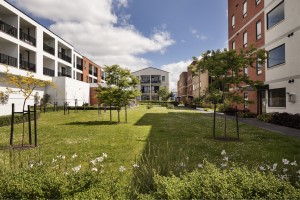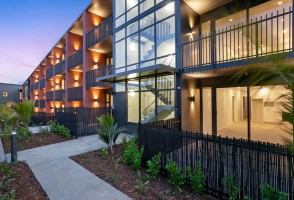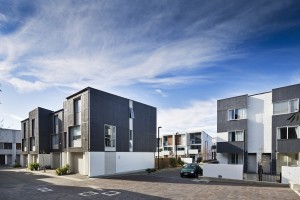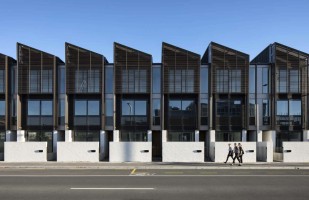Overview
The Marley dBlue® acoustic plumbing system is engineered from a combination of polypropylene and sound absorbing mineral filler (PP-MD). The DWV system is designed to minimise the transfer of both air-borne and structure-borne noise from sanitary and drainage plumbing applications. As such it is particularly suitable
for inter-tenancy applications in multi-unit developments.
dBlue’s triple layered polypropylene pipe offers a combination of acoustic performance, weight, chemical and temperature resistance with mechanical strength. Impact resistant and tough, dBlue has been independently tested to meet industry acoustic benchmarks without the need for lagging. No lagging means the system requires less install time, reduces material use, and requires less space.
Application
The dBlue system is imported from Europe and meets higher standards than those in New Zealand. The dBlue system has a siphon boss gully trap of the same design as the Marley OPTIM® Compakt® and shorter than traditional boss gully traps (BGTs) — so similar inter-floor space saving benefits apply. Where dwellings have pipework running horizontally through the mid floor to connect bath, vanity etc. to the BGT (boss gull trap), they then run from that hub to the stack.
dBlue is a ring joint system, not a solvent joint system like PVC based systems. This means it is quicker to connect and there is no solvent to deal with — on top of the obvious benefits of no lagging. The dBlue system is highly applicable to MDH projects in NZ.
dBlue adheres to applicable plumbing standards including: AS/NZS 7671 Plastic piping systems for soil and waste discharge (low and high temperature) inside buildings –polypropylene (PP) / WaterMark WMK25729; AS/NZS 5065 Polyethylene and polypropylene pipes and fittings for drainage and sewerage applications / WaterMark WMK25751; and AS 2887 Plastic Waste Fittings / WaterMark WMK25952.
Note: dBlue is not intended for exposed installations. To meet acoustic requirements in habitable areas, the system must be separated from the living space by an industry standard ceiling or wall structure.
Design Flexibility
- Full range of pipes for any application: 50, 75, 110, and 160mm OD; lengths from 150mm to 3m.
- Full range of injection moulded components for flexibility of design and install including 15, 30, 45, and 88° bends.
- Fixed point and guide bracket options allow for expansion/ contraction.
- dBlue to PVC adaptors available for system integration.
Support
Marley’s nationwide territory manager team is available for training, onsite technical support, and post install inspection if required.
Sound reduction with Marley dBlue®
Noise in a soil and waste system is caused by wastewater flowing inside the system. The wastewater is turbulent and causes noise as well as vibrations in the pipe structure. The vibrations are emitted directly from the pipe surface as air-borne noise and as structure- borne noise to the wall or inter-floor structure through the fixing system. Marley dBlue® has been designed to reduce both air-borne and structure-borne noise.
How Marley dBlue® reduces air-borne noise
Air-borne noise is reduced using absorbent materials. The plastic PP-MD used for Marley dBlue® is a special formula adding sound-dampening mineral fillers with increased weight to maximise the absorbance of air-borne sound waves. The triple layer pipe and rubber ring joints further reduce acoustic vibration in the system.
How Marley dBlue® reduces structure-borne noise
Structure-borne noise is reduced by using soft material to acoustically uncouple the vibrating source or impact event. The dBlue® acoustic bracket has a special rubber lining designed to best uncouple any vibrations from the pipe system. The combination of all these features is what makes Marley dBlue® a system that takes reduction of soil and waste noise to the next level. Non-system specific installation practice will also help achieve a lower noise level, e.g. installing the pipe system to the heaviest wall; properly insulating the pipe where it passes through building slabs and other structural barriers.
Fire
Marley dBlue® has fire behaviour class B2 (normally inflammable) according to DIN 4102-1 and class E (normally inflammable) according to EN 13501-1. When Marley dBlue® passes through fire-rated building elements it is mandatory to install fire protection collars that will not reduce the fire-rating of these building elements. The Marley dBlue® system dimensions can be installed in combination with a range of fire protection collars. The installed system needs to be in accordance with AS 1530.4. Marley advise to following the fire collar manufacturer’s guidelines with respect to design, installation, commissioning, and maintenance. Contact the responsible authority for compliance with applicable regulations. For example, see the Allproof Industries’ fire collar manual for their fire collar test results with dBlue®.
Acoustics
Marley dBlue® has been independently tested by the Commonwealth Scientific and Industrial Research Organisation (CSIRO). The system meets the Australian Rw + Ctr 25 and 40 benchmarks without the need for lagging when separated from the living space by an industry standard ceiling or wall structure.
Temperature Resistance
dBlue® has high temperature resistance (-10° to 90°) so is ideal for buildings with commercial kitchens such as rest homes. The pipes, fittings and seals can be used continuously at 90 ̊C and up to 95°C for brief periods. They are also suitable for the drainage of chemically aggressive wastewater with a pH value of 2 (acidic) to 12 (basic).



